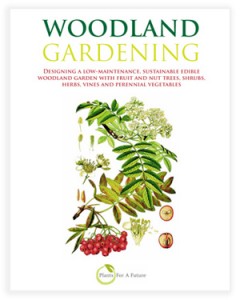“Woodland Gardening” from ‘Plants for a Future’.

A book entitled "Woodland Gardening" has grown out of a project that began back in 1980s / 90s. "Plants for a Future" began in 1989 when a 28 acre plot of land was bought by Ken and Addy Fern near Lostwithiel, Cornwall. The aim was to demonstrate the importance and many uses of plants, particularly perennials using permaculture techniques. This is in marked contrast to many aspects of current agricultural practice, which involves the constant working of the soil, the intensive use of 'agro-chemicals' and a heavy reliance of a limited palette of annual crops.
Their woodland gardening 'seeks to emulate beneficial aspects of natural woodland'. In woodlands, trees, shrubs and herbs all grow alongside one another year after year, offering shelter and food to various animals, including us. The soil is stable and its structure and fertility are maintained through the natural recycling of materials and nutrients.
It is possible to grow a variety of useful plants in a manner similar to that seen in woodland; one example would be to have fruit and nut trees under-planted with smaller trees and shrubs, together with climbers and ground cover plants.  Such an arrangement optimises the available area and can yield edible fruits, nuts, leaves and roots throughout the year (indeed, at the rather dry top of my garden I have a somewhat curious mixture of cherry, blackthorn, hazel, beech, hawthorn, a 'reluctant' quince, a vine, together with raspberries, rosemary and globe artichokes, plus patches of oregano and sage).
Such an arrangement optimises the available area and can yield edible fruits, nuts, leaves and roots throughout the year (indeed, at the rather dry top of my garden I have a somewhat curious mixture of cherry, blackthorn, hazel, beech, hawthorn, a 'reluctant' quince, a vine, together with raspberries, rosemary and globe artichokes, plus patches of oregano and sage).
The book "Woodland Gardening" suggest how it is possible to create a woodland garden in a relatively small area. It explains the value of growing a variety of perennials and offers an introduction to many of the species that can be cultivated in such a setting. The book is available through the Plants for a Future website as an eBook download, or from Amazon in a traditional format.
Further information on over 7000 plant species, including edible and medicinal plants can be found on the Plants for a Future database - which can be accessed here. The featured image (above) is the cover of the book, taken from their website.
Comments are closed for this post.
Discussion
I particularly welcome this site, as over the past 34 years my husband and I have been turning our 3/8 – 5 pole – back garden into an entirely chemical-free, woodland, with the specific aim of encouraging wildlife. How exciting to know that what started off being pooh-poohed all those years ago is finally coming into its own :-) Even the smallest spaces, if carefully managed, can become thriving copses of mixed trees. I’m downloading the book and look forward with great anticipation to reading it.


Excellent – as one of the founder members of Newcastle Organic Gardeners over 20 years ago, I have been aware of all this and been wanting to put it into practice in a woodland setting along with ‘alternative’ agroecology practices; just a question of finding the right place!?
Peter
1 September, 2015